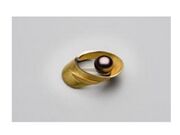Difference between revisions of "Black pearl"
(username removed) |
|||
| (4 intermediate revisions by 4 users not shown) | |||
| Line 1: | Line 1: | ||
| + | [[File:Black pearl ring 20152129.jpg|thumb|Tahitian black pearl<br>MFA# 2015.2129]] | ||
== Description == | == Description == | ||
| − | A rare, [ | + | A rare, [[pearl]] with an iridescent black color produced by black lipped oysters. Natural black pearls were indigenous to waters near Peru, Panama, and islands in Polynesia, Indonesia and the Phillipines. By 1900, overharvesting resulted in the near elimination of oysters that produced the black pearls. Because of their value, black pearls are often simulated by artificial methods. Prior to the 1970s, most commercial black pearls were dyed by soaking in a weak solution of [[silver nitrate]] and dilute [[ammonium%20hydroxide|ammonia]]. The black color was then developed by exposure to light or [[hydrogen sulfide]] gas. Another method used gamma radiation to change the color of Akoya pearls from white to black. Since 1966, techniques were developed for culturing black pearls at fairly rapid rates (2 mm per year). |
== Synonyms and Related Terms == | == Synonyms and Related Terms == | ||
| Line 7: | Line 8: | ||
black pearls; gray pearls; grey pearls; Tahitian pearls. Polynesian pearls; zwarte parel (Ned.) | black pearls; gray pearls; grey pearls; Tahitian pearls. Polynesian pearls; zwarte parel (Ned.) | ||
| − | == | + | == Risks == |
| − | + | * Easily damaged by acids. | |
| + | * Deteriorates at low humidities. | ||
| + | * Easily scratched. | ||
| + | *m May be discolored by soap or skin oil. | ||
| − | + | ==Physical and Chemical Properties== | |
| − | + | * Natural and cultured black pearls: fluoresce reddish brown in long UV light | |
| + | * Dyed black pearls and irradiated do not fluoresce. | ||
| − | + | ==Resources and Citations== | |
| − | + | * Pearl: [http://www.geo.utexas.edu/courses/347k/redesign/gem_notes/pearl/pearl_main.htm Website] | |
| − | + | * Website: http://www.geo.utexas.edu/courses/347k/redesign/gem_notes/pearl/pearl_main.htm | |
| − | + | * Website: http://www.perlesdetahiti.net/index.php?key=2 | |
| − | |||
| − | * Website | ||
| − | |||
| − | |||
[[Category:Materials database]] | [[Category:Materials database]] | ||
Latest revision as of 07:53, 8 May 2022
Description
A rare, Pearl with an iridescent black color produced by black lipped oysters. Natural black pearls were indigenous to waters near Peru, Panama, and islands in Polynesia, Indonesia and the Phillipines. By 1900, overharvesting resulted in the near elimination of oysters that produced the black pearls. Because of their value, black pearls are often simulated by artificial methods. Prior to the 1970s, most commercial black pearls were dyed by soaking in a weak solution of Silver nitrate and dilute ammonia. The black color was then developed by exposure to light or Hydrogen sulfide gas. Another method used gamma radiation to change the color of Akoya pearls from white to black. Since 1966, techniques were developed for culturing black pearls at fairly rapid rates (2 mm per year).
Synonyms and Related Terms
black pearls; gray pearls; grey pearls; Tahitian pearls. Polynesian pearls; zwarte parel (Ned.)
Risks
- Easily damaged by acids.
- Deteriorates at low humidities.
- Easily scratched.
- m May be discolored by soap or skin oil.
Physical and Chemical Properties
- Natural and cultured black pearls: fluoresce reddish brown in long UV light
- Dyed black pearls and irradiated do not fluoresce.
Resources and Citations
- Pearl: Website
